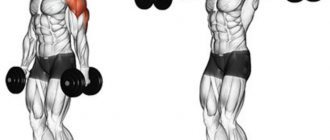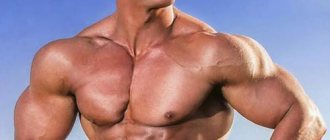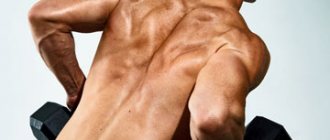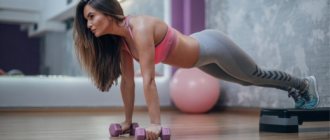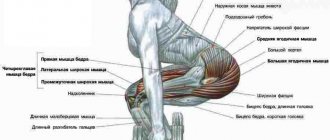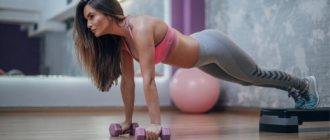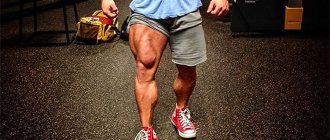Share:
What you need
- Dumbbells
- Barbell
- Exercise equipment
Beautiful and voluminous shoulders are an attractive appearance for both an athlete and an ordinary person. Developed shoulders bring the body shape closer to a V-shape, making the figure more athletic.
Let's look at some basic shoulder exercises that will help you achieve a powerful upper body and will be an excellent incentive for further muscle gain.
How to organize training correctly?
The decision to pump up your shoulders does not arise out of nowhere. Either someone persistently recommended this to you, or in the process of working on yourself you felt that not everything was okay with this zone. In the first case, the most logical option is to start going to the gym. And you will definitely need a trainer who will assess your initial condition, set priorities and recommend a course of effective shoulder exercises.
If you are not new to sports, an instructor is not necessary: you will be able to develop a training plan yourself. It doesn’t matter where you train – in the gym or at home. The main thing is to have access to the necessary athletic equipment.
And don't forget the three principles of effective training:
- regularity;
- continuity;
- progressiveness.
In other words, classes need structure. Let the interval between training days be long but stable. The training process itself must be continuous. If you have allocated 1 hour for yourself, then you cannot take unplanned breaks during it. It is important to gradually increase the load, but at the same time maintain proper technique.
Training plan
To effectively pump your shoulders at home, you need a training program. We offer an example of such a program:
- Warm-up: swing rotations in the shoulder and elbow joints.
- Pull-ups on the horizontal bar (3-4/10-15).
- Corner push-ups (3-4/12-15).
- Military press (3-4/12-15).
- Bent-over dumbbell flyes (3-4/12-15).
- Elevated push-ups (3 sets to failure).
- If you're only training your shoulders, you can do this workout plan 2-3 times a week. Be sure to leave a rest day between classes.
- If you are working out your whole body and doing it on a split basis, we recommend combining the proposed program with training your back or legs.
The training plan is designed for 6-8 weeks. Then it needs to be changed.
Shoulder anatomy
The shoulder muscle is otherwise called the “delta” for its similarity to the triangular shape of the Latin letter of the same name. The biceps and triceps are located lower and do not belong to the deltoid muscle. Therefore, an athlete doing shoulder exercises must understand that as a result, only his upper arms will be pumped up, but not his arms themselves. It is for this reason that delt exercises are suitable for girls who want to have relatively broad shoulders, but do not want to be too muscular.
The deltoid muscle is attached to three bones: the humerus, scapula and clavicle. When performing exercises, take into account the individual characteristics of the body. If you have had fractures or dislocations of the listed bones, it is recommended to exercise only with a trainer, and loads should be limited. A similar requirement applies to injuries of the shoulder joints or their ligaments.
The delta consists of three bundles: anterior, middle (lateral) and posterior. Let's look at their location and participation in training in more detail in the table.
| Delta muscle bundles | Anatomy | Work in exercises |
| Front | Covers the shoulder joint from the front | Shoulder flexion and internal rotation, raising arms in front of you |
| Average | Covers the shoulder joint from above and from the side | Lateral shoulder abduction |
| Rear | Attached to the humerus from the upper back | Horizontal extension and external rotation of the shoulder |
© Alila Medical Media — stock.adobe.com
The two main functions of the delta are to push the load away from you and to pull it towards you. These two components give rise to all the variety of movements that we use in shoulder exercises. When we do front swings, dumbbell and barbell presses, we develop the pushing function (front beam). Swings from the sides or in an inclined position, as well as all kinds of traction, are the second component (middle and rear beams).
For the full development of deltas, you need to perform at least one exercise for each of the beams. Most often, athletes “fall out” of the back and middle ones, since the front one is quite easy to pump up thanks to its participation in all presses, and exercises for the other two beams are either neglected, or not done enough, or with the wrong technique (for example, swinging heavy dumbbells with cheating) .
Verified by NASA
NASA research has shown that the conditions under which you train do not matter for muscle growth. The muscles just need tension. It is this that stimulates their growth and increase in strength.
Kenneth Baldwin, a professor in the Department of Physiology and Biophysics at the University of California, supported by NASA, studied muscle growth in rats trained using different types of physical activity.
Through painless electrical stimulation, Baldwin stimulated the rats' muscles to contract isometrically (static contraction), isotonic (normal contraction), and eccentrically (negative contraction). The results forever closed the debate about the best way to train.
Baldwin stated, “We found that after 12 sessions of each type of training, the amount of muscle growth in each group was the same,” even with isometric exercises, which are not actual movements.
Warm-up
Warm-up is a very important step before every workout. In this case, it is necessary to warm up the shoulders and minimize injuries. For 5-10 minutes, perform simple warm-up exercises in the starting position - standing on the floor:
- Tilt your head in different directions and rotate in a circle.
- Circular rotation of the shoulders forward and backward.
- Alternately raising your arms up through the sides and lowering them.
- Horizontal swings of arms.
- Again, circular rotations with your arms back and forth. Then one hand forward and the other back. Change hands.
Shoulder injuries are one of the most common, so pay due attention to the warm-up and do it as thoroughly as possible.
Ways to increase shoulder width
Beginners who visit the gym for the first time begin to look for miracle exercises, magic powders and pills that will allow them to quickly achieve their goals.
But such methods do not exist, and only hard work for results is important. It is impossible to change the length of the bones that are responsible for the width of the shoulders with the help of exercises. The problem can be solved in two ways:
- development of deltoid muscles
- expansion of the chest and bones of the shoulder girdle.
At the same time, age is of particular importance when creating a training schedule. If a person is under 20 years old, then it makes sense to work on expanding the chest. Wide-grip pull-ups and dumbbell pullovers will help with this. However, after passing this age limit, bone growth stops, so it makes sense to focus on the development of the deltoid muscles.
They make up the main part of the shoulder body and are divided into anterior, posterior and lateral. To achieve quick results and visually enlarge your shoulders, you need to focus on exercises from the last muscle group.
Basic exercises
We bring to your attention several of the most effective basic shoulder exercises so that you can choose the most suitable ones for yourself. It is better to do the first few workouts with an instructor so that he can control you, explain and show you the technique.
Also, do not forget about isolation exercises - most movements for the middle and posterior bundles are exactly like this, but this does not mean that they are ineffective. You just need to competently combine base and isolation depending on your goals, length of service and training experience.
Barbell chest press standing and sitting
The standing chest press is also called the military press. This is the most effective exercise for developing the pushing function of the deltoid muscle.
And that's why:
- Free weight exercises work a lot of stabilizer muscles.
- Large range of motion: you can touch the barbell to your chest, you can lower it to your chin if you feel uncomfortable doing it too low.
- The exercise can be done by any person, not just weightlifters. It is enough to choose a comfortable weight.
Advice! The grip on the bar for this exercise should not be too wide or too narrow. Optimal option: slightly wider than shoulder width. The forearms in the starting position should be perpendicular to the floor. When lifting the barbell, do not follow it with your eyes. Don't extend your elbows all the way - this is true for all shoulder presses.
The exercise can also be done while sitting:
© Makatserchyk — stock.adobe.com
Many people think that this will reduce the load on the spine, but in fact the opposite is true - the load on the intervertebral discs in this movement will be greater in a sitting position. And if for small weights there is not much difference, and you can start doing the exercise while sitting, and then switch to the standing version, which is more difficult in terms of technique, then with large weights you should definitely work only in a standing position.
Another option is to sit in Smith. Here the movement will be strictly specified by the design of the simulator, which “turns off” some of the stabilizer muscles and makes the bench press itself a little easier. That's why the weights here will be a little higher. However, a given vector of movement can also be a problem - the risk of injury to the shoulder joints increases, since here you will not be able to move the projectile in the plane of the floor, only perpendicular to it.
© Makatserchyk — stock.adobe.com
Bench press standing and sitting
In this exercise you will take less weight than in the previous version, although the amplitude here is obviously shorter. But the shoulder joints have less freedom, which increases the risk of injury. In addition, you need to lower the projectile behind your head more slowly and under control - you can accidentally hit the back of your head.
Lift the barbell straight up from behind your head, in the same plane as your forearms. Leaning forward may cause you to fall and drop the projectile on your neck. And if you lean back, you can injure your shoulder joints. It is better to do this exercise in front of a mirror or with an instructor.
A similar exercise can be performed while sitting (including in Smith), but for this, as in the previous exercise, you need to have a pumped lower back and a healthy spine. It is also more difficult to throw the projectile in a sitting position. While standing, you can step back and forward to adjust your balance.
© Makatserchyk — stock.adobe.com
Many people believe that the exercise is aimed at developing the middle deltoids. They really work, but the front ones still take on more load. This is why all pressing exercises should be based on the front deltoids.
Attention! We do not recommend this exercise to anyone. Leave it to those who play sports professionally. The risk of injury to the shoulder joints is too high. This exercise can easily be replaced with a chest press or dumbbell press without loss of effectiveness.
Seated dumbbell press
Along with the military press, this is the best basic exercise for building massive deltoids. Many professional athletes even prefer it to the standing barbell press.
It is best to perform the exercise on a bench with the back set at an angle of 90 degrees or close to it. There is no need to touch the dumbbells at the top point; also, do not straighten your elbows completely. At the bottom, lower the shells to the maximum comfortable depth.
© Kurhan — stock.adobe.com
Arnold press
This is a variation of the previous exercise, which allows you to actively use, in addition to the front deltoid, the middle deltoid. It was named after Arnold Schwarzenegger, whose deltoids, by the way, were not very developed. But the actor-athlete still remains a standard for many athletes, and such a modification of the bench press is really very good for diversifying the training process.
The difference here is that in the starting position, the hands with dumbbells are in front of the head, and not at the side. The grip is reverse, that is, the palms are facing back. In the process of lifting the projectiles upward, the hands rotate 180 degrees. At the top point everything is similar to a simple dumbbell press. When lowering, a reverse reversal occurs.
The main feature of the Arnold press is that the shoulders are constantly under tension . That is, there are no points at which they rest.
Shoulder press in the machine
The movement also resembles a seated dumbbell press, but here the trajectory is strictly limited by the machine itself. Although this exercise is a basic one, it should not be done first, except in situations where it is used as a warm-up before a heavy military press. In general, it will be best to “finish off” the shoulders in the simulator after bench presses with free weights - this is the most effective scheme.
© Makatserchyk — stock.adobe.com
Standing barbell row to the chin
The barbell chin row engages the front or middle deltoid. If you use a close grip, you will hit the front bun and trapezius. To work out the middle bun, you need to take the bar with a wide grip and perform the movement using your elbows. There is no need to pull the barbell with your entire muscle mass; it is better to take a lighter weight, but work only with your elbows with your shoulders down. There is no need for cheating in this exercise.
If you don’t have a barbell, the exercise can be effectively performed with dumbbells:
© ruigsantos — stock.adobe.com
Wide grip bent over row
This is the second great exercise for the rear delts. The technique is in many ways similar to the bent-over barbell row for training the back muscles, but there are still differences. You need to take a grip wider than your shoulders and pull towards your collarbones. The elbows will look strictly to the sides of the body.
So, when we figured out the most effective exercises, it’s time to create several training complexes for deltoids.
